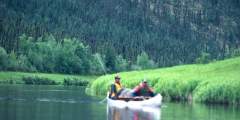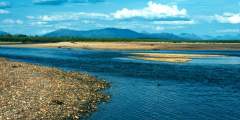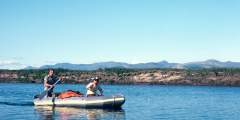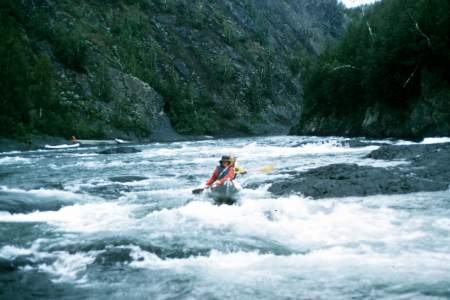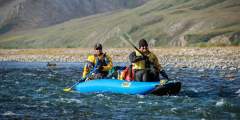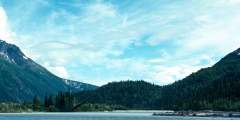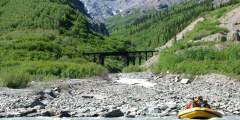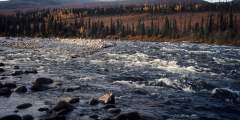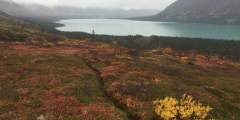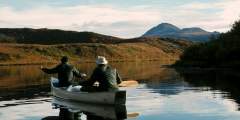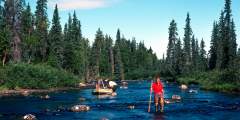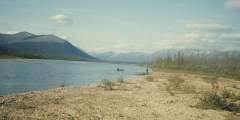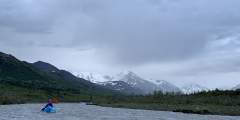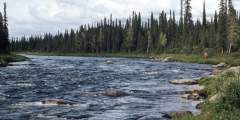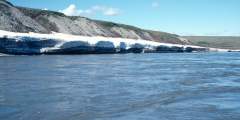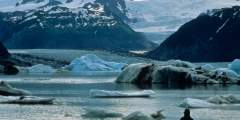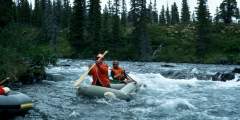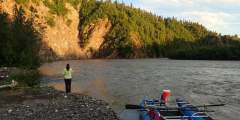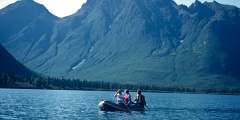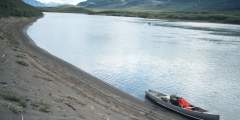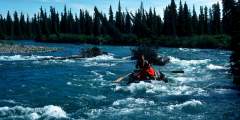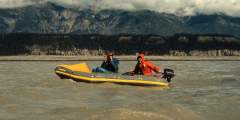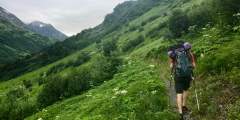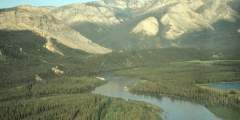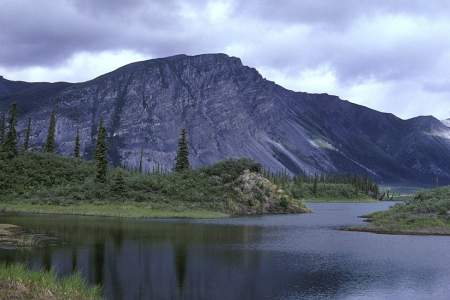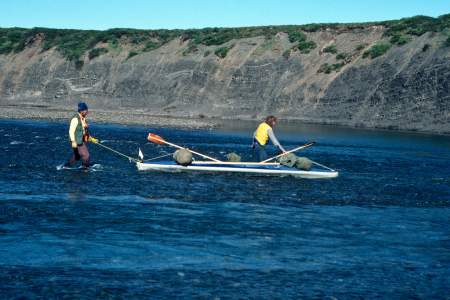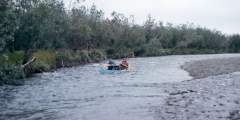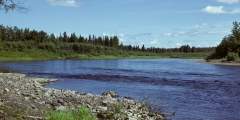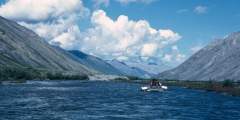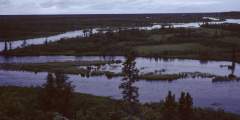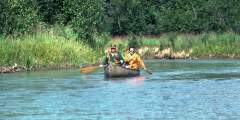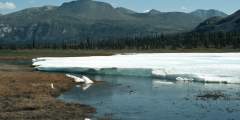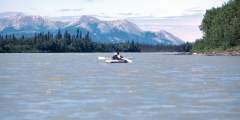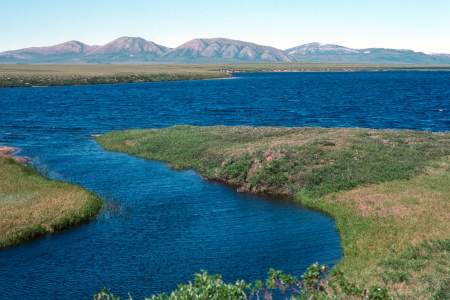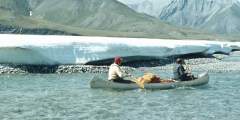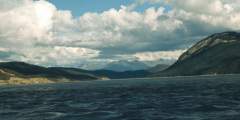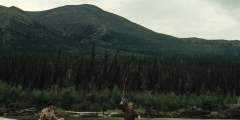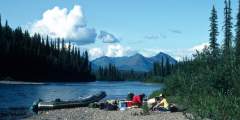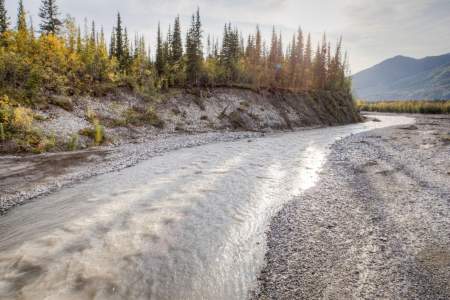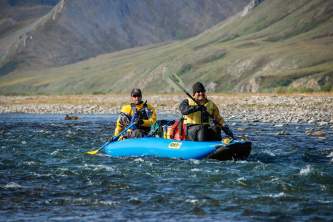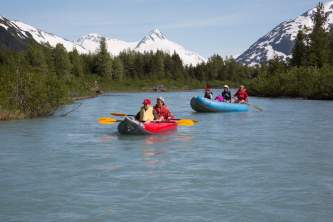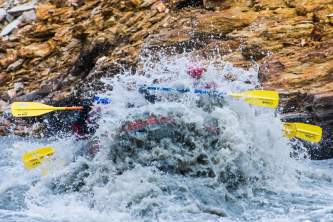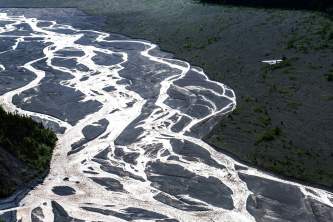Alaska Float Trips
Ever rafted a river in the Lower 48? That’s nothing like rafting in Alaska. Up here, those rivers are known as creeks. Alaska’s rivers are huge bodies of water that move fast, run deep, and are cold. Fed by snowmelt or glaciers, a flipped boat or swim in a river can lead to hypothermia. In short, Alaska rivers are serious forces of nature.
Floating down one of these aquatic highways is an unforgettable way to experience Alaska. Rivers take you quickly into the heart of the Alaskan wilderness, without the physical exertion of hiking or climbing. Everyone travels at the same pace, silently, watching the wildlife without scaring them away. And you can bring along little luxuries—an extra tent, good food, bottles of wine—that would make for an impossibly heavy backpack on a hiking trip.
So get out there and go rafting, Alaska style!
Trip Planning Considerations
Things to think about before you even start planning. Your answers will affect where in the state you go, what river you run, and what time of year you start out.
- Are you looking for whitewater/rapids or a scenic float?
- Is there particular wildlife you’d like to see?
- Are we experienced enough for the river we want to float, or should we hire a guide?
- Should we shuttle cars at drop-off & pick-up spots, or budget for air service?
- Does anyone want to fish or go for day hikes?
- Pick up a copy of The Alaska River Guide, a great resource for investigating floatable rivers.
Trip Preparations
Some things to think about before you set out:
- How comfortable are you and/or your group being alone in the wilderness?
- Who have you talked to about this river?
- Are there significant winds?
- Any tricky rapids or good camp spots to be looking for?
- Did you talk to anyone about the water level?
- What will the weather be like?
- Where’s the patch kit?
- What is the bear situation?
- What is the weather like? Is there an optimal month or time for this river, especially as it relates to water flows?
What Kind of Boat?
Everyone uses self-bailing boats nowadays. But you will have to decide between:
- Paddle rafting. Each person has their own paddle; you work together to maneuver the boat. This gives everyone an activity, but has limited gear capacity.
- Oar rafting. One person paddles using oars on a metal frame. Unless your paddlers are all very strong, oar rafting gives you more control over the boat. Those not manning the oars can relax and watch the scenery go by.
- On harder rivers, try to have more than one boat in case one boat dumps, loses gear, or rafters fall out. The other boat can help with rescue and recovering gear, though you should lash your gear to the boat so it won’t fall out—even if the boat turns upside down and scrapes the rocky bottom.
Show Map
Float Trips
Overview The Marsh Fork is a tributary of the Canning River, an arctic river that forms the western boundary of the Arctic National Wildlife Refuge and flows through the dramatic Phillip Smith Mountains and past the Franklin Mountains. The trip we describe is a 35-mile section of the Marsh Fork and a 5‑mile stretch of the Canning River to the first takeout option that is a gravel strip at Plunge Creek. The Marsh Fork requires some Class… ...more
The Chena River flows 50 miles from the White Mountains through Fairbanks. Fed by five tributaries, it is a Class II river with logjams, small channels, and campgrounds. The Middle Fork serves as the main section. The Chena Hot Springs Resort is a common starting point. With interesting features along its length, the river takes 5 to 7 days to complete.
Overview Located in southwestern Alaska, in one of the richest fisheries in the world, the Wood-Tikchik State Park has a great, easy to moderate float trip that is perfect for families with wilderness camping experience and for diehard fishing enthusiasts. From the furthest inland lake to Dillingham, Alaska is a 130-mile trip that involves paddling your way the length of 4 large lakes and down the three rivers that connect the lakes and then… ...more
The Aniuk River flows 80 miles from Howard Pass to the Noatak River, offering a remote, scenic route with rocky rapids and rich wildlife. It traverses alpine tundra, marshy valleys, and upland habitats in the Noatak National Preserve. The river is above the tree line and follows a historic migratory path. A trip takes 4 – 6 days, with Cutler River as the first exit. Inflatable kayaks and canoes are ideal.
Overview The Nowitna River, or Novi as locals refer to it, is a non-glacial Class I river with a short bit of Class II river flowing north of the Kuskokwim Mountains and is a National Wild and Scenic River. Much of its length is within the Nowitna National Wildlife Refuge, and for over 300 miles, this tea-colored river slowly flows out of the Susulatna Hills and Sunshine Mountains, through wooded and hilly terrain, en route to its confluence… ...more
Class III Packrafting River. Remote and exotic landscape. 30 miles hiking, 30 miles floating. Fly-in to Port Heiden, fly-out from Aniakchak Bay. Aniakchak River, a remote 35-mile Class IV run, flows from Surprise Lake through a volcanic caldera and dense brown bear habitat to the Pacific. The trip takes 3 – 4 days, ending in Aniakchak Bay. Weather can be severe, with July as the best rafting month. The route features rugged terrain, fast waters, ...more
While the North Fork of Eagle River is only 40 minutes from Anchorage, it has as much beauty and some of the hazards of much bigger, more remote Alaska rivers. Class I and only 7 miles long, this float is still fairly-committing, especially during low water when the entire trip from the mile 7.4 put in to the take out can take 4 – 5 hours on the water. The river isn’t braided so you’re in one channel the entire float, but there are a lot of… ...more
Overview With the Talkeetna Mountains to the north and the Chugach Mountains to the south, the Matanuska River pours forth from the large Matanuska Glacier in a swift, freezing cold, torrent of Class II to Class IV whitewater for nearly 70 miles before it meets the sea where the Knik Arm of Cook Inlet reaches into the interior. The river runs down the trench formed where the Border Ranges Fault line separates the two mighty mountain ranges,… ...more
Overview The Salmon River, a designated National Wild and Scenic River, located in the Kobuk River National Park is a clear waterway with exceptional scenic attributes traversing a variety of vegetative zones as it flows south out of the Baird Mountains to its confluence with the Kobuk River. Gin clear and without any obstacles, it is a Class I river for the 45 miles to where it joins the Kobuk River. There is an additional 48 miles of… ...more
Overview The Squirrel River is a very clear, small volume arctic river flowing south out of the foothills of the Baird Mountains to where it joins the Kobuk River at the village of Kiana. This is an easy float and well suited to families or beginner paddlers that are competent wilderness campers. There is good hiking in the upper mountainous region and good fishing all along the way. After August, water levels become low and the upper… ...more
The John River is a classic stretch of arctic river: scenically spectacular, clear with good fishing, great hiking in the upper reaches, no dangerous sections of river and lots of wildlife viewing opportunities. It flows swiftly, south out of the arctic interior through Anaktuvuk Pass into the rugged Endicott Moutains and represents a path from the Inuit culture of the north to the Athabaskan culture of the forested interior. To the north,… ...more
The Trip Drain Creek to the Gorge: 16 miles The upper section is all shallow braids where the river winds its way through the British Mountains, an area of beautiful limestone cliffs rich with fossils. This is an area of some of the best high ridge hikes that are accessible from most camps. There are several good campsites that are just downriver of the landing strip making it fairly easy to launch the same day if there is another… ...more
A trip down the Firth River, with its headwaters in Alaska and most of the river located in Canada, is a river trip with no parallel. It is said to be Canada’s oldest river having been a refugium where the ice of the last ice age never existed. As a result, its landscape is rugged and craggy and its riverbed without glacial outwash gravels. Located within Ivvavik National Park in Canada’s northern Yukon, the river lies across the migratory… ...more
Overview This river is a little known river, short in length but long in attributes, that flows in one of Alaska’s premier wilderness parklands, Lake Clark National Park and Preserve. With the Neocola Mountains to the north and the Chigmit Mountains to the south, the river sits in a geographically important site where the Alaska Range ends and the Aleutian Range begins. The scenery along the river’s narrow mountain lined valley is the river’s… ...more
The Nenana River, a glacial river, forms the eastern boundary of Denali National Park and is possibly the most popular river rafting destination in the state. It offers a variety of levels of difficulty and has a thriving commercial rafting industry that operates 2 hour, 4 hour and overnight trips for locals as well as out of state tourists.
The Charley River, a National Wild and Scenic waterway, flows 108 miles to the Yukon, passing through valleys, cliffs, and floodplains. It offers clear waters, hiking, and whitewater, with Class II-III rapids and occasional Class IV in high water. Rich in history, it has evidence of early occupants and gold mining relics. Most trips cover 88 miles in 6 – 10 days, making it a premier Alaskan wilderness adventure.
Located in southwest Alaska and flowing out of the Ahklun Mountains to the Bering Sea, the North Fork of the Goodnews River is an ideal family and/or friends, 5 day float trip of 60 miles on an easy river that is choked with fish in the summer months. The upper half lies within designated wilderness in the Togiak National Wildlife Refuge and is surrounded by green tundra covered mountains and has good current in the upper reaches with little… ...more
A combination of classic Alaskana: float planes, big mountains, crystal blue lakes, and homesteading history. This “route” is uniquely freeform. You’ll be able to choose from hundreds of available hiking options. With the vast majority of the paddling being on flat water this is a great option for a novice packrafter.
The Delta River, including Tangle Lakes to mile 212 on the Richardson Highway, is an outstanding river to float, although there is a set of falls to portage around. It offers a variety of water challenges: quiet lake, fast and rocky Class I to the falls, good Class II rapids following the falls, Class I meandering water to Eureka Creek, and fast glacial water to the takeout 7 miles below Eureka Creek. The scenery is superb with canyon,… ...more
Overview The Talachulitna or “Tal” as it is commonly referred to, is located totally within state patented lands. When people talk of floating the Tal it is usually a 5 to 7 day trip, down Talachulitna Creek and then down the Talachulitna River to the Skwentna River. From the start at a headwater lake there are 16 miles of shallow Class I creek and then 32 miles on the Tal with Class I to IV rapids, depending on water levels, and an additional… ...more
The Ambler River is an 80-mile clear water route from the Schwatka Mountains to the Kobuk River, featuring rocky rapids, braided channels, and a challenging 3‑mile canyon. Its diverse habitat supports Sheefish, making it great for fishing. The journey, ideal for kayaks and canoes, takes 6 – 8 days, allowing for a mix of adventure and relaxation through forested and open landscapes.
The Holitna River is an easy flowing river in southwest Alaska, running through a vast wilderness area. Flowing north along the base of the Kuskokwim Mountains and out of the Taylor Mountains, the Holitna is the largest river system in the lower Kuskokwim River basin and offers a great family and friends trip in a true wilderness setting with a chance to meet local natives at the village of Kashegelok in the river’s headwater area. From the… ...more
Experience the backcountry of Denali National Park in a way few others do. You’ll board a bus from the Visitor Center and disembark just before Sable Pass and then immerse yourself in the wild Alaska landscape. Recommended for intermediate backpackers and beginner packrafters.
This bit of river system is a crystalline, spring-fed watershed that flows into the Tanana River and is famous as being the largest documented spawning area for Coho Salmon of the entire Yukon River system. It is a fairly short river of 20 miles with 12 miles you can float, but when combined with the 30 miles of Tanana River down to the Alcan Highway Bridge, a long weekend or up to a 3 day trip is possible and is entirely accessible by car.… ...more
The Gulkana River is an approximately 80-mile long river that can be done in 5 to 7 average length days. It is a National Wild and Scenic River and one of Alaska’s most popular whitewater river trips. It is an excellent fishing river trip, as well, with a large King Salmon run and lots of smaller sport fish to try for. The first three miles are, generally, Class II with 4 mph current and some Class III. The next 13 to 15 miles to canyon… ...more
Overview The Noatak River flows through the largest undisturbed watershed in North America and is listed as an International Biosphere Reserve as well as having a National Wild and Scenic River status. It starts in the dramatic, granitic, Endicott and Schwatka Mountains in the Gates of the Arctic National Park of the Brooks Range, flowing along at a leisurely pace in a westerly direction for 300 miles, then turning to the south for another 100… ...more
The Alsek River is a powerful, glacial-fed waterway flowing from Canada to Alaska through vast protected wilderness. It features massive glaciers, swift whitewater, and the highest concentration of grizzlies in North America. The journey includes a mandatory helicopter portage at Turnback Canyon and takes 13 – 16 days. Harsh weather and complex logistics make it a true expedition, best suited for expert paddlers.
The Hula Hula River is sometimes referred to as the quintessential arctic river trip. It has a generous amount of whitewater and mountain scenery as well as several days of the arctic coastal plains where the river plunges through the often discussed 10 02 Land, the calving grounds for the Porcupine Caribou Herd. This is the controversial land that is part of the “drill for oil on the calving grounds” debate that we hear about. The trip… ...more
A major tributary of the Yukon River, the Fortymile is a clear water stream that has 6 main forks flowing east of the Mertie Mountains and north of the Tanana State Forest area, out of the Yukon-Tanana Uplands, not far south of the Arctic Circle. To the west of the Mertie Mountains is the Charley River and the mountain ridgeline is the boundary for the Yukon-Charley Rivers National Preserve to the west. Both the Charley and the Fortymile are… ...more
Overview Six Mile Creek is, perhaps, Alaska’s most accessible technical whitewater run, well suited to kayak or paddle raft, mostly Class IV and one class V canyon. Flowing in the rugged Chugach Mountains of the Kenai Peninsula, within Chugach National Forest, this stream has a reputation of booming whitewater and fast gorge style rapids. A small volume stream, it has 3 distinct canyons, with each one more difficult than the previous. At most… ...more
Flowing out of the western edge of the Chugach Mountains, the Kenai River runs turquoise blue from Kenai Lake through canyons and whitewater till it spills out onto the low elevation woodlands to where it finally meets the salt water of Cook Inlet near the town of Kenai. For almost 80 miles the river frolics through 3 sets of whitewater and forms 7‑mile long Skilak Lake. A trip of 4 to 5 days is an ideal time to spend on this world-class… ...more
Overview The Tana River is a short, challenging Class IV+ stretch of river that leads to the Chitina River. It flows out of the Chugach Mountains directly towards the Wrangell Mountains and has a reputation that deserves skill and experience paddling along fast, cold glacier water. It starts as a medium size river flowing out of the Tana Glacier that is an ice tributary of the giant Bagley Ice Field. The Tana River alone is only 36 miles… ...more
The Chulitna River flows to the south out of a huge valley from Broad Pass, one of only two breaks in the Alaska Range Mountains, where the highway, the train, the geese, and the river, all pass on their way to Cook Inlet. It offers a chance for a float of 75 miles and can take as little as 3 days in kayaks but can be a nice 4 or 5‑day trip. Canoes and kayaks are fun on the upper but tippy on the lower section. There are three forks of the… ...more
Overview The Wild River is not as wild as the country around it. In fact, it is one of the best family float trips that is available to those who want a dose of wilderness that is far from the security of the neighborhood watch group. It is a 63-mile trip from where it heads in a lake nestled in a lovely forested valley to where it joins the Koyukuk River and flows past the town of Bettles, and is easily floated in 6 days time. It is a Class I… ...more
The Killik River begins in the northern portion of Gates of the Arctic National Park and flows north 135 miles to where it joins the Colville River at what is known as the Killik Bend. There is a 105-mile and a 90-mile section of river accessible to rafters and makes for a good 7 to 10 day trip. The river starts in the Endicott Mountains, in the region of Survey Pass at about GPS N 67 degrees and W 46.5 minutes, and flows through a broad,… ...more
The Chilikadrotna River, a Wild and Scenic River, flows 60 miles through Lake Clark National Park to the Mulchatna River. Averaging 5 mph, it runs through birch and spruce forests with jagged peaks above. The trip takes 4 – 8 days, featuring swift water, rapids, and occasional sweepers. A popular fly-in fishing spot, it offers thrilling whitewater for experienced boaters in an 82-mile journey.
Overview This interesting combination of rivers and lake is a rarely done circuit that would be a great multi-day wilderness float trip for kayaks and rafts. With good fishing opportunities and only Class III at times, it is mostly a Class II trip and for 80 miles it travels through an amazing landscape. The Nelchina River system is a rocky glacial river with daily water level fluctuations amid a forested valley and with spectacular views of… ...more
Lake Creek is one of south central Alaska’s most famous streams, primarily due to its superior salmon runs. King Salmon use Lake Creek and Chelatna Lake as a spawning site and return in large numbers and trout and grayling follow right behind them. Lake Creek is a clear, swift, and at times, very strong river with two sections of Class III+ and IV rapids and many technical boulder garden rapids to get through. The two hardest sections can be… ...more
The Chitina River flows down a huge valley that traces a path separating the Wrangell Mountains and the St Elias Mountains of Alaska’s southeastern mountain region. This river trip can be done in 4 to 8 days depending on where you start your trip. This valley sits astride a giant fault line that runs through a region that has formed as colliding tectonic plates have pushed up some of the highest mountains in North America with Mt Logan… ...more
The Winner Creek to 20 Mile River loop is a great first packrafting trip. For those with packrafting skills, this route offers a quick, easy-to-access, multi-sport adventure. The hike up to Berry Pass is seriously underrated, and the views of the 20 Mile watershed are absolutely stunning.
The Alatna River, a wild and scenic river in Alaska, flows 184 miles from the Brooks Range to Allakaket. It passes Circle Lake, the Arrigetch Peaks, and Helpmejack Hills, offering stunning views. The upper section is rocky with Class II+ rapids, while the lower section mellows into meandering boreal forest. A popular float trip destination, it takes 4 – 14 days, best navigated by inflatable kayak or small raft.
Overview Flowing south away from the Kuskokwim Mountains and out of the Nushagak Hills and into Nushagak Bay of the world famous Bristol Bay region, this river represents one of the most important fishery habitats in southwest Alaska. For 275 miles this river runs as a Class I river that is well suited for families that have good wilderness camping skills and enjoy interactions with local native peoples as it flows past several native… ...more
Overview The Sheenjek River begins in a near arctic environment and travels hundreds of miles into the subarctic, flowing a southerly route out of the Romanzof Mountains, within Alaska’s Brooks Range. It carries a National Wild and Scenic River distinction and offers several options for extended trips into a vast wilderness. The greatest distance one can travel is about 290 miles from its headwaters to the town of Fort Yukon along the… ...more
The Colville River rises in an isolated area of the DeLong Mountains, at the western end of the Brooks Range, north of the continental divide in the southwestern corner of the National Petroleum Reserve. It flows initially north, then generally east through the foothills on the north side of the range, broadening into a wide tundra expanse as it receives the inflow of tributaries that descend from the middle Brooks Range. It is a major river… ...more
This is an easy float (Class I & II) on the largest tributary of the Holitna River. Like the Holitna this is a world class fishing destination. The river begins at the large Whitefish Lake and passes through a lot of windy, slow turns moving on its long trip down to meet the Holitna River and eventually to the Kuskokwim River. It is a remote, rarely traveled river, and it is very unlikely that you will see any other people. The upper… ...more
The Kanektok River is located in the Togiak National Wildlife Reserve of Southwest Alaska and flows westward 85 miles from Pegati Lake and into the Bering Sea at the city of Quinhagak. It starts in the scenic Ahklun Mountains then spills out across the Kuskokwim lowlands and is a fly fisherman’s paradise. It is a world class fishing destination and sees quite a bit of fishing from lodges nearby and from fishing camps along the river.… ...more
The Andreafsky and East Fork Rivers are remote, Wild and Scenic waterways in Alaska, flowing 105 – 122 miles through tundra and forest. This Class I river is ideal for a 5 – 7 day float, best suited for inflatable kayaks or small rafts. The East Fork features more trees and bogs, while the area is home to diverse wildlife, including the rare Bristle-thighed Curlew. Few travel here outside of local groups and fishing parties.
The Chatanika River, a Class II stream in the Yukon River drainage, flows from the Alaska Range through valleys before reaching Minto Flats. Ideal for canoes and kayaks, it includes the 28-mile Chatanika River Canoe Trail, a BLM-registered route. The longest floatable section is 45 miles, taking 3 to 4 days. The river features clear or lightly tannic waters and offers a scenic wilderness experience.
Portage Creek is the easiest float near Anchorage, a 1 – 2 hour float down flat water with the option of take outs at mile 4.5 or 6.5. With kids, however, you’ll want to turn it into a half-day adventure, stopping on gravel bars to play and explore. You’re never far from Portage Valley Road, which can provide a sense of comfort. Even though the road does not have a deep wilderness feel, you are surrounded by several-thousand foot mountains which… ...more
Overview Within the Brooks Range lies the Endicott Mountains and in the heart of these mountains is the Gates of The Arctic National Park and Preserve. Where the mountains rise to meet the sky the beginnings of the North Fork of the Koyukuk River lie. This is a river that begins in these mountains and eventually flows into the giant Yukon-Kusko delta region. But at its start are the 7000-foot high mountains of the Gates, with Mt Doonerak the… ...more
The Canning River flows from the Phillip Smith Mountains, forming the Arctic Refuge’s western boundary. Ideal for small boats, it features a wide, glacier-carved valley with meandering channels. Though not a whitewater challenge, low water levels can make navigation tricky. A 14-foot raft or inflatable kayak works best. Expeditions Alaska offers 7 – 12 day guided trips through this remote Arctic wilderness.
The Alagnak river, a federally designated Wild and Scenic River that originates in Katmai National Park and Preserve, is a fisherman’s paradise and the most popular fishing float trip in the Bristol Bay region. From it’s headwaters at Kukaklek or Nonvianuk Lake, it is a 75 mile Class I and II river with one Class III canyon that is a mile long and has a short falls, not easily portaged or lined due to the steep walls. The river is a good… ...more
Overview The Yanert River is a little known gem that is the largest tributary of the quite popular Nenana River, which forms the eastern boundary of Denali National Park. It flows rapidly through a braided glacial outwash plain that fills a section of the ancient Hines Creek Fault line, and marks the zone of collision between ancient and newer tectonic plates. There is a short but deep gorge and the river is only 20 miles in length but by… ...more
Overview The Little Su, as it is known, is a clear stream that flows out of the Talkeetna Mountains and through a constricted, boulder-choked canyon before becoming a mild, meandering river. It is a relatively small stream, warmer than most Alaskan rivers and offers two distinct type trips. One is a Class IV+, 7‑mile section of near continuous whitewater suitable, only for skilled kayakers, and is the upper most section of river that you can… ...more
Overview The Porcupine River begins in the vast reaches of interior Canada in the Ogilvie Mountains and travels 300 miles of Canadian waterway and 200 miles of Alaskan waterway, to where it joins the Yukon River near Fort Yukon. It is a Class I wilderness trip that is suitable for anyone comfortable with camping in mosquito and bear country and flows through the boreal forest of spruce, birch, poplar and willow. It has headwaters that join… ...more
Overview The Nabesna River is a glacially fed Class I and II river that flows north out of the heart of the Wrangell-St Elias Mountains and cuts through a shallow canyon between the Mentasta Mountains and the Nutzotin Mountains of south central Alaska. It joins the Chisana River and, together, they form the mighty Tanana River, which flows through interior Alaska to its confluence with the Yukon. The river has 80 miles to float through, in an… ...more
The Happy River is a gem of an Alaska Range River. Located in a vast wilderness and draining the south slopes from Rainy Pass, and flowing into the much larger Skwentna River, it is a swift, rocky river of moderate to slightly above moderate difficulty. Kayakers find it an easy run, while it presents several challenges to rafting parties. In the upper valley the river is within a most gorgeous location with swift, continuous but small rapids, ...more
Float Through Anchorage Neighborhoods
Overview Beginning far up into the mountains of Lake Clark National Park, the Stony River is a little known but beautiful glacial river that flows south away from the Revelation Mountains and out of Sled Pass to a point where it then flows northwest through the rolling foothills to where it eventually joins the Kuskokwim River near the village of Stony River. The upper 50 miles of river are inaccessible and rarely see summertime traffic.… ...more
Overview The Nigu and Etivluk Rivers, beginning in Gates of the Arctic National Park, are seldom-visited river valleys in the high arctic at above 68 degrees north latitude and flow north out of the Brooks Range to join the Colville River. Beginning in the mountains, the rivers flow north from the Brooks Range, out of the eastern edge of the DeLong Mountains into the Arctic foothills through rolling hills and tundra. Both rivers carry small… ...more
The Chickaloon River flows from the Talkeetna Mountains to the Matanuska River. A 33-mile Class II-III+ stretch offers fast, continuous rapids with some blind drops requiring scouting. This is not for beginners but is an excellent weekend trip for experienced rafters with good gear and read-and-run skills. The river is glacial-fed, and access to the upper sections is limited, often requiring helicopter transport.
The 95-mile long Ivishak River flows north, through the Philip Smith Mountains and the northern foothills of the Arctic National Wildlife Refuge, to join the Sagavanirktok River on the coastal plain, 50 miles south of Prudhoe Bay. Fed by glaciers in the headwaters area, the Ivishak starts at a lake in a glacial trough and flows quickly through rocky riffles for 8 miles, then forms a single channel for a third of its length before becoming an… ...more
The Copper River and its many tributaries drain one of the greatest regions of mountain, ice, snow and forest in North America. It is a giant river in its lower reaches, often flowing at rates over 200,000 cubic feet per second, while its headwater tributaries flow down steep, rocky gorges and through wide, braided glacial valleys. It is in a region that encompasses subarctic to temperate zones within a latitude range of 60 to 62 degrees. It… ...more
Overview The Nizina River flows out of the Nizina Glacier and into the heart of the Wrangell Mountains from a point not far from the divide with the St Elias Mountains to the east. This area is a part of the largest protected parklands in the world and from near its source, it offers a 45-mile or 90-mile trip with moderate Class III difficulties. It is a tributary of the Chitina River that flows into the even larger Copper River. The… ...more
Overview The Talkeetna River is, according to almost every guidebook or reference you may consult, the most classic, wilderness, whitewater trip in Alaska. Its remote location, steep, fast-water canyon, abundant fishing and wildlife viewing make it one of the true classics for sure. It requires a bush plane to fly into the Talkeetna Mountains where there are huge views of the highest peak in North America, Denali, and in the headwaters area… ...more
Beaver Creek National Wild and Scenic River has its headwaters in the White Mountains, north of Fairbanks, Alaska. The river flows west past the jagged limestone ridges of the White Mountains before flowing to the north and east, where it enters the Yukon Flats and joins the Yukon River. It is one of the few road accessible streams in Alaska with a Wild and Scenic designation. The first 127 miles of Beaver Creek were designated a National… ...more
The upper Kobuk River traverses a wide, forest-covered valley with sweeping views from the river of nearby mountains. From its start at Walker Lake the river is in the Gates of the Arctic National Preserve and it has several Class IV challenges as well as miles of Class I river. A wilderness environment exists downstream to approximately the Pah River area. Further downriver, the Kobuk is a major travel corridor for local inhabitants and… ...more


